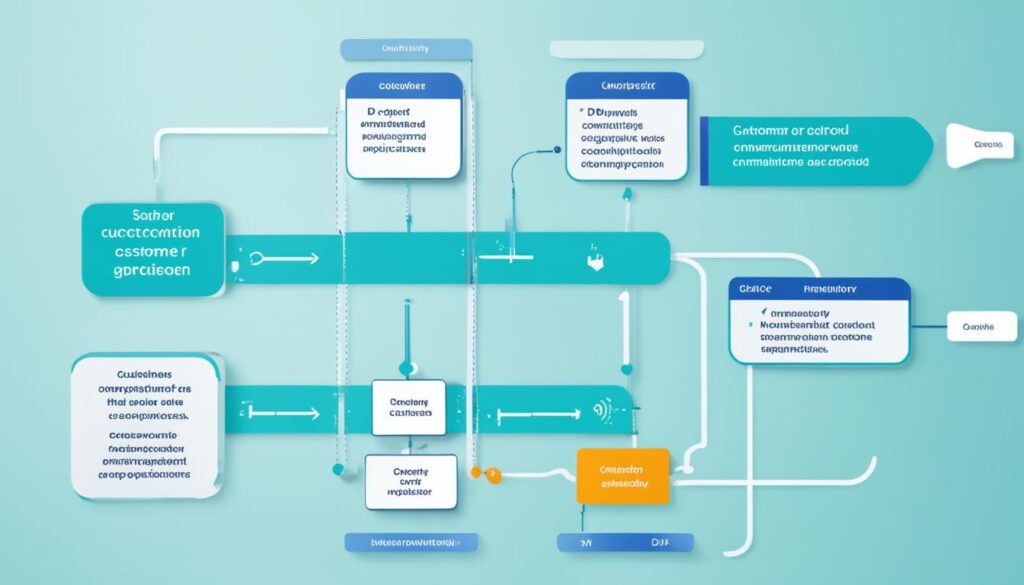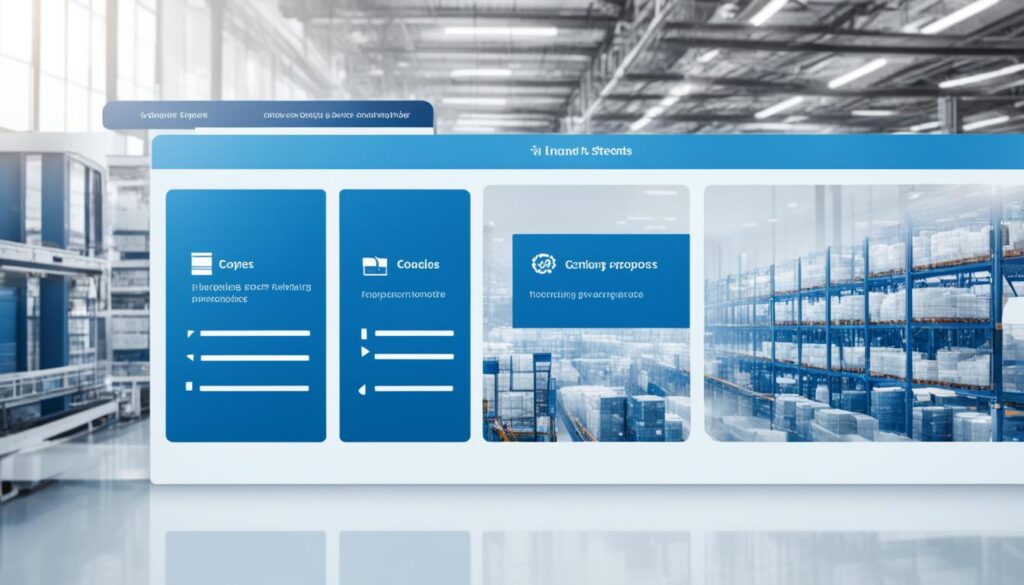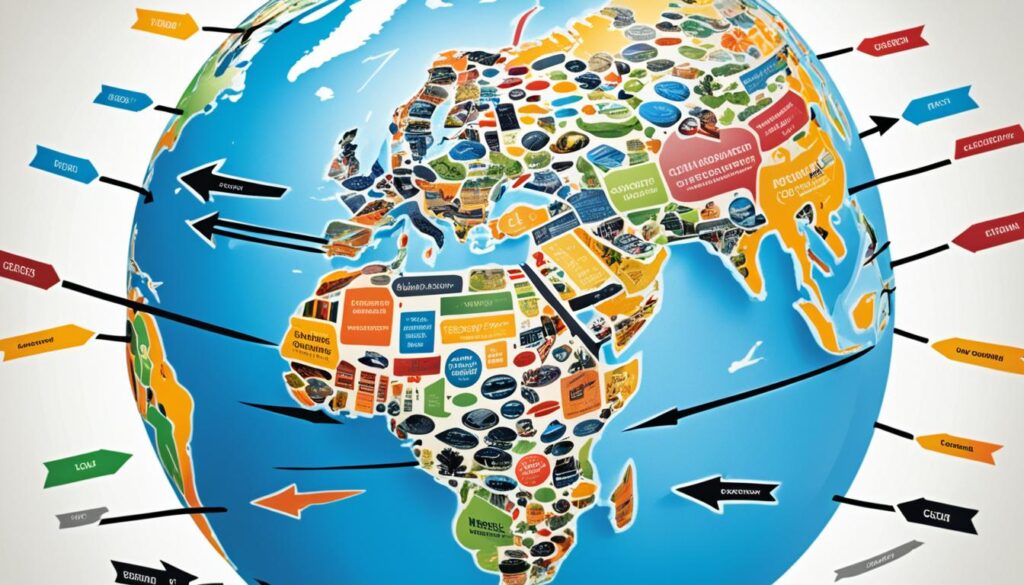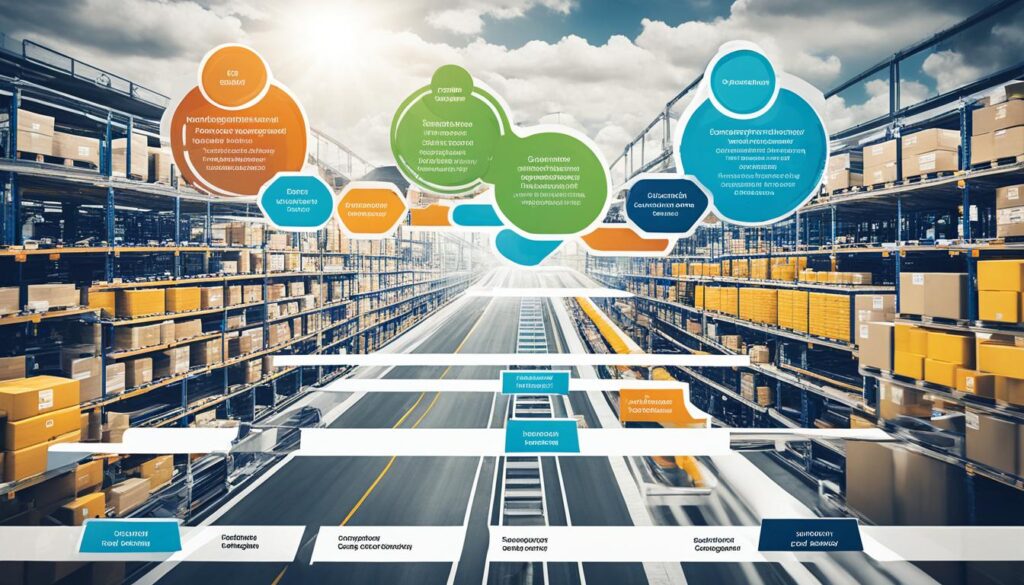Have you ever wondered how products make their way from manufacturers to consumers? How do goods find their way onto store shelves or into online marketplaces? The answer lies in the intricate network of retail middlemen.
Retail middlemen, also known as retail brokers, distributors, or sales agents, are the unsung heroes of the retail industry. They operate behind the scenes, connecting producers with consumers and ensuring a smooth flow of goods and services.
But what exactly do these middlemen do? How do they contribute to the success of businesses? In this quick guide, I’ll take you through the world of retail middlemen, exploring their roles, types, and the pros and cons of working with them.
So, if you’re ready to unravel the mysteries of the retail supply chain and gain a deeper understanding of how products reach your hands, let’s dive in!
Key Takeaways:
- Retail middlemen act as intermediaries in the supply chain, bridging the gap between producers and consumers.
- There are different types of middlemen, including agents, brokers, distributors, and retailers.
- Using middlemen offers benefits such as efficient utilization of resources, better marketing coverage, and customer convenience.
- However, there are drawbacks to consider, such as reduced profit for manufacturers and higher prices for retailers and customers.
- The rise of direct-to-consumer (D2C) models has challenged traditional middlemen and provided new opportunities for businesses.
Types of Middlemen in the Retail Industry
When it comes to the retail industry, various types of middlemen play important roles in the distribution process. These middlemen can be categorized into agents, brokers, distributors, and retailers, each serving a unique function in the supply chain.
Agents and Brokers
Agents and brokers act as intermediaries between buyers and sellers. They work to connect the two parties and facilitate transactions, earning commissions or fees for their services. Agents typically represent either the buyer or the seller and provide assistance throughout the negotiation and purchasing process.
Distributors
Distributors are chosen by manufacturers to distribute goods to wholesalers or retailers. They serve as a link between the producer and the rest of the supply chain, ensuring that products reach the intended market. Distributors often have established networks and logistics capabilities to efficiently transport and store inventory.
Retailers
Retailers are the final middlemen in the retail industry who purchase products from wholesalers and sell them in small amounts to end consumers. They operate physical stores, online platforms, or a combination of both, providing convenience and accessibility to customers. Retailers play a vital role in marketing, merchandising, and creating a compelling shopping experience.
Wholesalers
Wholesalers serve as a bridge between producers and retailers or other businesses. They buy products in bulk from producers and resell them to retailers, helping to streamline the distribution process. Wholesalers often provide additional services such as inventory management and product sourcing, catering to the specific needs of retailers.
| Type of Middlemen | Description |
|---|---|
| Agents and Brokers | Intermediaries connecting buyers and sellers, earning commissions or fees for their services. |
| Distributors | Chosen by manufacturers to distribute goods to wholesalers or retailers. |
| Retailers | Purchase products from wholesalers and sell them to end consumers. |
| Wholesalers | Purchase products in bulk from producers and resell them to retailers or businesses. |
Understanding the different types of middlemen in the retail industry is essential for businesses looking to effectively navigate the complex supply chain. Each type of middleman has distinct roles and responsibilities, contributing to the smooth flow of products from producers to end consumers.

Benefits of Using Middlemen in Business
In today’s fast-paced business environment, middlemen play a crucial role in facilitating smooth transactions between producers and consumers. They bring a host of benefits that contribute to the efficient functioning of supply chains and the overall success of businesses.
1. Efficient Utilization of Time and Resources
Middlemen act as a single point of contact for multiple transactions, consolidating various activities and streamlining the distribution process. This efficient utilization of time and resources enables businesses to focus on their core competencies while relying on experts to handle the intricacies of the market.
2. Better Marketing Coverage
Middlemen provide businesses with extensive marketing coverage by leveraging their networks, relationships, and expertise. They have a deep understanding of market trends, consumers’ preferences, and the competitive landscape. Through their efforts, businesses can reach a larger customer base across different channels, enhancing brand visibility and sales.
3. Customer Convenience
One of the significant advantages of using middlemen is the convenience they offer to customers. These intermediaries provide one-stop shopping experiences, allowing customers to find a wide range of products in a single location. Additionally, middlemen often handle product delivery, ensuring a seamless experience for customers.
4. Seasonal Product Availability
Middlemen play a pivotal role in ensuring seasonal product availability. They possess the necessary resources and networks to acquire and distribute goods during specific seasons when they are in high demand. This enables businesses to optimize their operations and meet market demands efficiently.
5. Superior Market Knowledge
Market knowledge is crucial for businesses to adapt and thrive in an ever-changing market landscape. Middlemen are well-versed in market trends, consumer behavior, and competitor activities. By working closely with middlemen, businesses can stay updated on relevant market information and make informed decisions regarding product development, pricing, and distribution strategies.
“Middlemen bring invaluable expertise, connections, and efficiency to the business ecosystem, allowing manufacturers and consumers to benefit from their value-added services.”
In conclusion, the benefits of using middlemen in business are undeniable. They offer efficient utilization of time and resources, better marketing coverage, customer convenience, seasonal product availability, and superior market knowledge. By leveraging the expertise and networks of middlemen, businesses can optimize their operations, reach a wider customer base, and stay ahead in today’s competitive market.

Drawbacks of Using Middlemen in Business
While middlemen offer benefits, there are also drawbacks to consider. Using middlemen can result in reduced profit for manufacturers, as each middleman takes a cut from the selling price. Middlemen may also have more power in the relationship, leading to imbalances. Additionally, working with middlemen can result in higher prices for retailers and ultimately customers, as costs from the supply chain are passed on.
| Drawback | Description |
|---|---|
| Reduced Profit for Manufacturers | As middlemen take a portion of the selling price, manufacturers may experience reduced profit margins. |
| Power Imbalance | Middlemen may hold more power in the business relationship, leading to imbalances and potential disadvantages for manufacturers. |
| Higher Prices for Retailers and Customers | Costs incurred from the involvement of middlemen in the supply chain can be passed on to retailers and ultimately result in higher prices for customers. |
While middlemen play a crucial role in the distribution process, it is important for businesses to carefully evaluate the trade-offs and consider alternative approaches such as direct-to-consumer models to mitigate these drawbacks.

The Rise of Direct-to-Consumer (D2C) Models
The rapid development of e-commerce and digital platforms has given rise to the emergence of direct-to-consumer (D2C) models, revolutionizing the way businesses connect with their customers. This new approach allows manufacturers and retailers to bypass traditional middlemen and establish direct relationships with consumers.
One of the key drivers of the D2C movement is the widespread adoption of e-commerce platforms. These online marketplaces provide businesses with the infrastructure and tools needed to sell their products directly to customers, eliminating the need for intermediaries. Additionally, the advent of drop-shipping has further simplified the process by allowing businesses to partner with suppliers who handle the fulfillment and shipping processes on their behalf.
Social media platforms have also played a significant role in the rise of D2C models. With billions of users worldwide, platforms like Facebook, Instagram, and Twitter provide manufacturers with direct access to their target audience. By leveraging social media, businesses can not only showcase their products and build brand awareness but also engage with customers on a more personal level. These platforms enable direct communication, allowing businesses to collect valuable market insights and feedback, driving continuous improvement and innovation.
Moreover, the D2C approach contributes to sustainability efforts by shortening the supply chain. By eliminating unnecessary intermediaries, businesses can reduce transportation and overhead costs, minimizing their carbon footprint. Additionally, the transparency that comes with D2C models allows businesses to showcase their commitment to sustainable practices, appealing to environmentally conscious consumers.
In summary, the rise of direct-to-consumer (D2C) models has revolutionized the retail landscape, empowering businesses to establish direct relationships with their customers. Through e-commerce platforms, drop-shipping, and social media, manufacturers can sell their products directly, while gaining valuable insights and fostering sustainability efforts. This shift in the retail paradigm has opened up new possibilities for businesses, enabling them to offer a more personalized, convenient, and sustainable shopping experience.
Pros of Direct-to-Consumer (D2C) Models
Direct-to-consumer (D2C) models offer numerous advantages for businesses looking to streamline their operations and enhance profitability. By eliminating middlemen, companies can maintain greater control over their financial outcomes, resulting in increased profit margins and enhanced growth potential.
Control Over Profitability
One of the primary benefits of adopting a D2C model is the ability for businesses to have direct control over their profitability. Without the presence of middlemen, companies can retain a larger portion of their profits by cutting out additional commissions and fees. This increased control allows businesses to make more informed decisions regarding pricing strategies, promotional offers, and cost management, ultimately driving their overall profitability.
Customer Data Access
Another notable advantage of D2C models is the direct access to valuable customer data. By selling products directly to consumers, businesses can gather detailed insights into customer preferences, behaviors, and purchasing patterns. This data enables companies to personalize their marketing efforts, tailoring product recommendations and promotions to individual customers. By leveraging customer data, businesses can enhance customer experience and build stronger brand loyalty.
Personalization
D2C models also enable companies to deliver highly personalized experiences to their customers. With direct access to consumer data, businesses can create customized product offerings and tailor messaging based on individual preferences. By understanding customer needs and preferences, businesses can provide personalized recommendations, targeted marketing campaigns, and enhanced customer support, fostering stronger relationships with their customer base.
Profit Maximization
By eliminating intermediaries, D2C models allow businesses to maximize their profits. Without the need to share revenue with middlemen, companies can reinvest a larger portion of their earnings into areas such as product development, marketing, or customer acquisition. This increased profitability potential can lead to sustainable growth and the ability to reinvest profits back into the business for innovation and expansion.
Innovation
One of the key advantages of D2C models is the ability for businesses to drive innovation through direct control of the entire supply chain. By selling directly to customers, companies can gather real-time feedback and insights about their products, allowing them to iterate, improve, and innovate more efficiently. Without the communication barriers presented by middlemen, businesses can respond quickly to market demands, introduce new products, and enhance existing offerings to meet customer needs effectively.
Overall, adopting a D2C model provides businesses with increased control over profitability, direct access to valuable customer data, the ability to personalize customer experiences, the potential for profit maximization, and the freedom to drive innovation. By leveraging these advantages, companies can optimize their operations, enhance customer satisfaction, and achieve sustainable growth in today’s competitive market.
| Pros of Direct-to-Consumer (D2C) Models |
|---|
| Control over profitability |
| Customer data access |
| Personalization |
| Profit maximization |
| Innovation |

Cons of Direct-to-Consumer (D2C) Models
While direct-to-consumer (D2C) models offer numerous advantages, they also come with certain challenges that businesses need to consider. Let’s take a closer look at some of the cons:
-
Hurdles to Growth
Expanding into omnichannel approaches can pose hurdles to growth for businesses adopting D2C models. This is especially true for companies transitioning from traditional supply chains to a direct-to-consumer model. Adapting to different channels and managing multiple touchpoints requires strategic planning and resource allocation.
-
Increased Responsibility
With a D2C model, businesses must bear the full responsibility for all aspects of the supply chain. This includes manufacturing, warehousing, order fulfillment, and customer support. Handling these responsibilities in-house demands additional resources, expertise, and operational capabilities.
-
Marketing Costs
Establishing a brand presence and reaching customers without the assistance of traditional retailers can significantly increase marketing costs for businesses using D2C models. Without the promotional support provided by middlemen, businesses must invest in various marketing strategies and channels to attract and retain customers.
Despite these challenges, businesses can overcome the cons by developing effective strategies, leveraging technology, and adopting best practices in direct-to-consumer operations.
Successful Examples of Direct-to-Consumer (D2C) Brands
Several companies have successfully implemented direct-to-consumer (D2C) models, harnessing the power of e-commerce and innovative marketing strategies. These brands have revolutionized their respective industries and gained a loyal customer base. Let’s take a closer look at some of the most successful D2C brands:
Oura
Oura offers personalized health insights through its smart rings. The rings track various biometric data, including sleep patterns, heart rate, and activity levels, providing users with actionable insights to improve their well-being.
Casper
Casper disrupted the mattress industry with its convenient bed-in-a-box model. By offering high-quality mattresses directly to customers, Casper eliminated the need for traditional middlemen, providing a seamless and affordable sleep experience.
Dollar Shave Club
Dollar Shave Club gained popularity with its subscription-based personalized shaving tools. By delivering high-quality razors and grooming products directly to customers’ doors, the company offered convenience and cost savings along with a personalized experience.
Bombas
Bombas differentiated itself in the apparel industry by focusing on its strong ethical values and charitable giving. For every pair of socks purchased, Bombas donates a pair to someone in need. This one-to-one donation model resonated with customers and helped the brand stand out.
Nanit
Nanit provides personalized insights for baby sleep monitoring devices. Its innovative technology and data-driven approach help parents track their baby’s sleep patterns and receive personalized recommendations for better sleep habits.
Warby Parker
Warby Parker revolutionized the eyewear industry with its online-first approach. By offering affordable and stylish prescription glasses and sunglasses, Warby Parker made eyewear accessible to a wider audience, challenging traditional brick-and-mortar stores.

These successful D2C brands have demonstrated the power of direct-to-consumer models in reaching customers, offering personalized experiences, and disrupting traditional industries. By leveraging technology and adopting customer-centric strategies, these brands have successfully bypassed middlemen and built direct relationships with their customers.
| Brand | Industry | Key Differentiator |
|---|---|---|
| Oura | Health and Wellness | Personalized health insights |
| Casper | Home and Furniture | Convenient bed-in-a-box model |
| Dollar Shave Club | Personal Care | Subscription-based personalized shaving tools |
| Bombas | Apparel | Strong ethical values, one-to-one donation model |
| Nanit | Parenting | Personalized insights for baby sleep monitoring |
| Warby Parker | Eyewear | Online-first model for affordable prescription glasses |
These brands have successfully disrupted their industries, offering innovative products, personalized experiences, and a direct connection with customers. As more businesses embrace the D2C model, these success stories serve as an inspiration for aspiring entrepreneurs looking to build their own direct-to-consumer brands.
Best Practices for Direct-to-Consumer (D2C) Success
When it comes to succeeding with a direct-to-consumer (D2C) model, businesses need to prioritize certain best practices. By following these guidelines, companies can effectively navigate the D2C landscape and achieve their goals.
A Customer-Centric Approach
One of the key D2C best practices is adopting a customer-centric approach. This means placing the customer at the center of all decision-making processes. By understanding their needs, preferences, and pain points, businesses can create personalized experiences that resonate with their target audience.
Data-Driven Decision-Making
Data-driven decision-making is another crucial aspect of D2C success. By leveraging customer data, market trends, and analytics, businesses can gain valuable insights that inform their strategies. This enables them to make informed decisions, adapt their product offerings, and stay ahead of the competition.
Omnichannel Strategy
An effective omnichannel strategy is essential for D2C success. By implementing a seamless experience across multiple channels, including online platforms, physical stores, and mobile apps, businesses can reach customers wherever they are. This enhances brand visibility, improves customer engagement, and drives sales.
Brand Differentiation
Brand differentiation is a critical element of standing out in the D2C landscape. With numerous brands vying for customers’ attention, it’s essential to establish a unique and compelling brand identity. By clearly communicating their value proposition, highlighting their unique selling points, and delivering exceptional customer experiences, businesses can differentiate themselves from competitors.
“To succeed with a direct-to-consumer (D2C) model, businesses should adopt a customer-centric approach, focus on data-driven decision-making, implement an omnichannel strategy, and prioritize brand differentiation.”
Implementing these best practices can position businesses for success in the D2C space. By prioritizing the customer, leveraging data, embracing omnichannel channels, and differentiating their brand, companies can maximize their potential and achieve their goals.
| Best Practices | Description |
|---|---|
| Customer-Centric Approach | Placing the customer at the center of decision-making, creating personalized experiences |
| Data-Driven Decision-Making | Using customer data and market insights to inform strategies and adapt product offerings |
| Omnichannel Strategy | Implementing a seamless experience across multiple channels to reach customers effectively |
| Brand Differentiation | Developing a unique brand identity that sets the business apart from competitors |
Following these D2C best practices can provide businesses with a solid foundation for success in today’s competitive market. By embracing a customer-centric approach, leveraging data, implementing an omnichannel strategy, and prioritizing brand differentiation, companies can thrive in the direct-to-consumer landscape.
Conclusion
Retail middlemen are essential players in the distribution industry, providing valuable services that facilitate the efficient flow of goods and services. They offer numerous benefits to businesses, including the effective utilization of resources, broader marketing coverage, and enhanced customer convenience. However, the emergence of direct-to-consumer (D2C) models has disrupted the traditional role of middlemen, presenting new opportunities for businesses to connect directly with customers.
D2C models empower businesses with increased control over profitability, as they eliminate the need to share profits with middlemen. Furthermore, they gain access to valuable customer data, enabling personalized marketing and the ability to tailor the customer experience. Several successful D2C brands have demonstrated the efficacy of this approach, revolutionizing industries such as health tech (Oura), bedding (Casper), shaving (Dollar Shave Club), socks (Bombas), baby care (Nanit), and eyewear (Warby Parker).
However, businesses pursuing D2C models should be mindful of the challenges involved. Expanding into omnichannel approaches and assuming full responsibility for the entire supply chain can pose hurdles to growth. Additionally, marketing costs may rise as businesses establish their brand without the support of traditional retailers.
By understanding the role of retail middlemen and the possibilities of D2C models, businesses can make informed decisions and optimize their supply chain for success. Striking a balance between utilizing middlemen’s advantages and embracing D2C strategies can create a winning formula for businesses seeking growth and profitability in the ever-evolving retail landscape.






